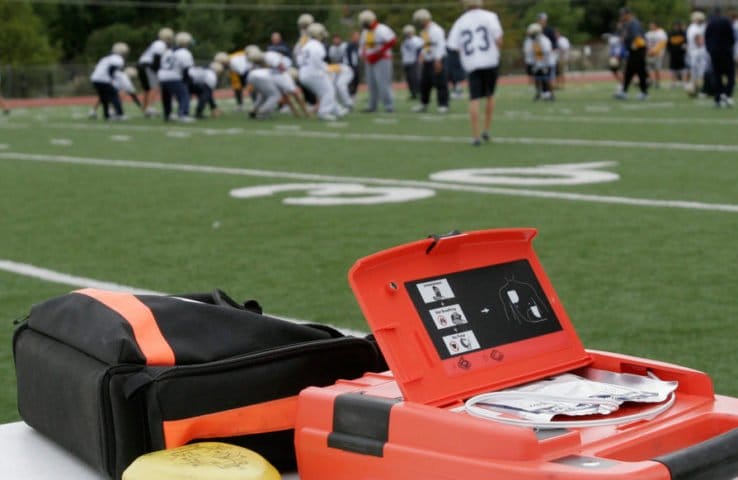What is Sudden Cardiac Arrest?
Sudden Cardiac Arrest (SCA) is a life-threatening emergency that occurs when the heart suddenly stops beating. It strikes people of all ages who may seem to be healthy, even children and teens.
When SCA happens, the person collapses and doesn’t respond or breathe normally. They may gasp or shake as if having a seizure.
SCA leads to death in minutes if the person does not get help right away. Survival depends on people nearby calling 911, starting CPR1, and using an AED2 (if available) as soon as possible.
The American Heart Association quotes more than 356,000 out-of-hospital cardiac arrests annually; 347,422 adults and 7,037 children under age 18 (2018). This equates to one youth stricken, nearly every hour, every day, every year.
1CPR: Cardiopulmonary resuscitation is when you push hard and fast on the center of the chest to make the heart pump; compressions may be given with or without rescue breaths.
2AED: Automated external defibrillator is a device that analyzes the heart and if it detects a problem may deliver a shock to restart the heart’s normal rhythm.

But what most parents don’t know IS that SCA is:
- the #1 killer of student athletes
- and contributes to the #2 medical cause of death among youth under 25
The American Heart Association reports that up to 9,500 youth are affected annually by what the National Heart, Lung, and Blood Institute calls a public health issue.
- One student athlete dies every three days.
- SCA is the leading cause of death on school campuses.
- 1 in 300 youth have an undetected heart condition that puts them at risk for SCA.
SCA is the #1 Killer of Student Athletes
According to the American Heart Association, nearly 325,000 youth and adults experience a Sudden Cardiac Arrest each year. Between 2,000-9,000 of these arrests occur in kids and teens. Some estimates place the incidence of SCA in youth as affecting 16 kids per day in the U.S. In the past, SCA has been difficult to quantify due to outdated data collection and preservation methods among medical examiners (such as labeling an SCA as a “heart attack” or using DNA preservatives that decrease the quality of the sample), but improvements are being made daily.
Youth Affected Each Year
Become Aware of Sudden Cardiac Arrest and What To Do
Although young people who have a family history of heart issues are at greater risk for Sudden Cardiac Arrest, SCA can happen in people who appear healthy and have no known risk factors for structural or arrhythmic heart issues. Teen and young adult athletes are at a greater risk for SCA due to commotio cordis, or a hit to the heart during play, or Hypertrophic Cardiomyopathy, or thickening of one wall of the heart that can be due to strenuous exercise.
Nearly 70% of the conditions that can cause SCA can be identified with a simple, non-invasive electrocardiogram (EKG or ECG) exam, yet EKG exams are not yet included in pediatric protocol for routine well-child visits. Some of the more prevalent conditions that are identified through EKG screenings include Long Q-T Syndrome, Wolff-Parkinson-White Syndrome, Hypertrophic Cardiomyopathy (HCM), Brugada Syndrome, Marfan Syndrome, and others. Most of these conditions are treatable. None of these conditions can be detected with a stethoscope.
%
70% of the conditions that can cause Sudden Cardiac Arrest can be identified with a simple, non-invasive electrocardiogram (EKG or ECG) exam
Signs & Symptoms of SCA
Usually, the first sign of sudden cardiac arrest (SCA) is a loss of consciousness (fainting). At the same time, no heartbeat (or pulse) can be felt.
Some people may have a racing heartbeat or feel dizzy or light-headed just before they faint. Within an hour before SCA, some people have chest pain, shortness of breath, nausea (feeling sick to the stomach), or vomiting.

What You Need to Do!
Cardiac arrest is reversible in most victims if it’s treated within the first few minutes. When someone is in SCA, he or she suddenly loses consciousness, normal breathing stops, and there are no signs of life.
Act Fast with these steps:
- Call 9-1-1 for emergency medical services.
- Begin CPR/AED. If an AED (automated external defibrillator) is available, or nearby, use it as soon as possible. Begin CPR immediately and continue until professional emergency medical services arrive. If two people are available to help, one should begin CPR immediately while the other calls 9-1-1 and find an AED.
- Get advanced care. After calling 9-1-1 the EMS and paramedics will be dispatched to the scene. First responders have the advanced training and equipment needed. You should continue CPR until advanced care arrives.
- Get quality advanced care.
Warning
One of the most common reasons SCA victims do not survive is that bystanders hesitate to call 9-1-1, start CPR and use AEDs right away. If you want to save a life, get involved. Your actions can only help. Doing nothing is the worst option.

Aidan’s Heart Foundation is a member of Parent Heart Watch.
